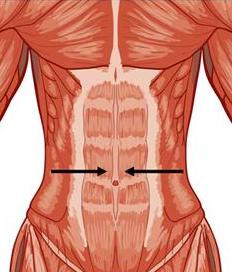
Rectus Abdominis Diastasis
Rectus Abdominis Diastasis

Often in cases of rectus abdominis diastasis, the rectus abdominis muscles are weak and their function is compromised. Because of the interconnectivity of the muscles via the linea alba, this impacts the deeper muscles of the abdomen and pelvis, resulting in a destabilised support system. Stable tendinous attachments are required for the abdominal muscles to transmit forces in the desired direction, and alterations of a muscle’s angle of insertion will a ect this function. Changes in rectus abdominis length, width and angle of insertion can occur after childbirth and are associated with a reduced ability to stabilise the lumbopelvic area (Gilleard & Brown, 1996).
As a result, rectus abdominis diastasis can have a number of implications for pre and post-natal women. It can a effect the stability of the trunk and may contribute to pelvic floor dysfunction, back and pelvic pain and hernias. A separation persisting after four weeks post-natal is likely to disrupt the function of the abdominal musculature. This may be a factor in persistent post-natal lumbar, pubic symphysis and sacroiliac joint pain and even incontinence due to the interaction of the pelvic floor and abdominal musculature as a stabilising unit.
Management of Rectus Abdominis Diasatsis
Exercises: A specifically tailored exercise program will focus on improving core stability, strengthening pelvic floor muscles and improving abdominal muscle tone. Breathing exercises help to retrain the diaphragm to relearn how to descend after childbirth. During pregnancy the diaphragm is pushed upwards by the growing uterus and loses its ability to descend during inhalation. Since the diaphragm forms the top of the core muscles, it is important to retrain it to function with a full excursion again.
Postural Awareness: After pregnancy women tend to stand with and an exaggerated anterior pelvic tilt and with their pelvis pushed forward. In order to stand up against gravity their bodies typically develop areas of rigidity in upper lumbar and lower thoracic area along with the buttock muscles. Manual therapy and relaxation exercises must be used prior to strengthening exercises.
Abdominal Support: In addition to a specific exercise program, abdominal muscle support (compression garments) is essential for the management of DRAM. This combination of compression and a tailored program will achieve optimal results. It is important that the correct type of compression garment is worn. The garments that achieve best results have gentle (medical graded) compression which promote supporting pressure to the pelvis, back and abdominal muscles. This stimulates strengthening of the abdominal muscles facilitating muscle recovery.
Education: Patients will learn new strategies for transferring load through the pelvis and spine so both the organs and the joints are supported and can function optimally. In some cases the diastasis gets smaller, and in other cases it doesn’t close but the abdominal wall is functional and there is a full return to activities without pain, incontinence or prolapse.
Contact our Duncraig Physio clinic for more information on Rectus Abdominis Diastasis.